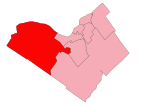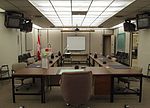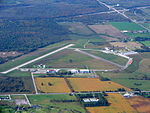West Carleton Township
1974 establishments in OntarioFormer municipalities now in OttawaFormer township municipalities in OntarioOttawa stubsPopulated places disestablished in 2000
West Carleton was a township municipality in Eastern Ontario, Canada. It was located in the rural parts of what is now the City of Ottawa, west of Kanata. Its northern boundary was the Ottawa River. The township was created in 1974 with the amalgamation of three townships: Torbolton, Fitzroy, and Huntley. In 2001 it was amalgamated with Cumberland, Gloucester, Goulbourn, Kanata, Nepean, Osgoode, Ottawa, Rideau, Rockcliffe Park and Vanier to form the new city of Ottawa. According to the Canada 2016 Census: Population: 21,547 % Change (2011–2016): +6.2% Dwellings: 8,596 Area (km²): 630.95 Density (persons per km²): 34.2
Excerpt from the Wikipedia article West Carleton Township (License: CC BY-SA 3.0, Authors).West Carleton Township
Thomas A. Dolan Parkway, Ottawa West Carleton-March (West Carleton)
Geographical coordinates (GPS) Address Nearby Places Show on map
Geographical coordinates (GPS)
| Latitude | Longitude |
|---|---|
| N 45.366666666667 ° | E -76.1 ° |
Address
Thomas A. Dolan Parkway
Thomas A. Dolan Parkway
Ottawa, West Carleton-March (West Carleton)
Ontario, Canada
Open on Google Maps







